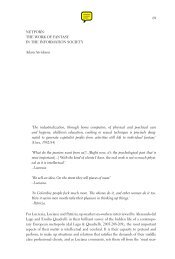Nakamura, Digitizing Race, Introduction, chapter 5, Epilogue
Nakamura, Digitizing Race, Introduction, chapter 5, Epilogue
Nakamura, Digitizing Race, Introduction, chapter 5, Epilogue
You also want an ePaper? Increase the reach of your titles
YUMPU automatically turns print PDFs into web optimized ePapers that Google loves.
<strong>Introduction</strong> 11<br />
the matrix of power. This is a crucial omission, because young people use<br />
IM a great deal. Chapter 1 of this book discusses the visual field of IM and<br />
its evolution from text-only forms of chat toward a form that includes userchosen<br />
and user-produced digital images of the body as an integral part of<br />
communication, signification, gendering, and racialization. Technological<br />
convergence is making all HCI spaces potential spaces for CMC, and vice<br />
versa. The continued existence of digital inequality necessitates considerations<br />
of identity and power relations—racial formation—along the axes of<br />
race, gender, and class. While Manovich’s Language of New Media stresses the<br />
importance of interfaces as vectors of ideology, there has yet to be a visually<br />
oriented critique of new media networked communications on the most<br />
popular network to date—the Internet—which considers these issues of<br />
raced and gendered bodies, both virtual and real.<br />
Visual culture studies was born in response to a crisis in art history: it is<br />
an insurgent art criticism that merges at some points with cultural studies<br />
but has different foundational texts that are oriented toward constructed<br />
social identities and a concern with the visual apparatus. Art history is a longstanding<br />
and canonized field in the letters and sciences and had become<br />
mired in debates regarding its adherence to traditional modes of analyzing<br />
visual objects that resulted in many scholars identifying against it. In theorizing<br />
digital racial formation theory, I am proposing a somewhat insurgent<br />
response to new media studies, a move that may seem premature considering<br />
its recent vintage. However, there are many advantages to correcting<br />
the omission in new media studies of gender, race, class, and communication<br />
as quickly as possible. Digital racial formation can trace the ways that<br />
race is formed online using visual images as part of the currency of communication<br />
and dialogue between users. Performing close readings of digital<br />
visual images on the Internet and their relation to identity, itself now an<br />
effect as well as a cause of digitality, produces a kind of critique that takes<br />
account of a visual practice that is quickly displacing television as a mediabased<br />
activity in the United States. 16<br />
Several visual culture anthologies have had a hand in shaping the field<br />
and its engagement with new media. Three of the most influential—Nicholas<br />
Mirzoeff’s <strong>Introduction</strong> to Visual Culture and Visual Culture Reader (first and<br />
second editions), Jessica Evans and Stuart Hall’s Visual Culture: The Reader,<br />
and John Walker and Sarah Chaplin’s Visual Culture: An <strong>Introduction</strong>—display<br />
varying degrees of engagement with digital culture. Armstrong’s fears of<br />
ungrounded “cyber critiques” that might be generated by visual culture studies<br />
are laid to rest after perusing these volumes, because they take pains to





